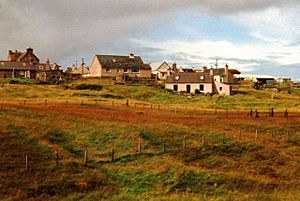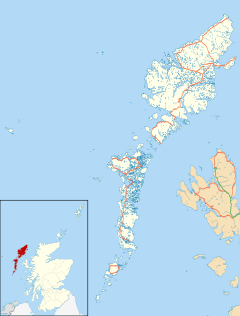South Dell facts for kids
Quick facts for kids South Dell
|
|
|---|---|
 Dail bho Dheas, South Dell |
|
| Language | Scottish Gaelic English |
| OS grid reference | NB483614 |
| Civil parish | |
| Council area | |
| Lieutenancy area | |
| Country | Scotland |
| Sovereign state | United Kingdom |
| Post town | STORNOWAY |
| Postcode district | HS2 |
| Dialling code | 01851 |
| Police | Northern |
| Fire | Highlands and Islands |
| Ambulance | Scottish |
| EU Parliament | Scotland |
| UK Parliament |
|
| Scottish Parliament |
|
South Dell (Scottish Gaelic: Dail-bho-Dheas) is a small village. It is found on the Isle of Lewis in Scotland. This island is part of the Outer Hebrides. South Dell is located in an area called Ness.
The village is within the parish of Barvas. It sits right next to the A857 road. The Dell River flows through the area. It separates South Dell from its neighbour, North Dell. Some artists, David Greenall and Ruth O'Dell, live in South Dell.
Contents
Discoveries from the Past
South Dell has a long history. People have found many old items here. These items tell us about life a very long time ago.
Ancient Weapons and Tools
In 1891 and 1892, two bronze swords were found. These swords are very old, from around 800 BC. That's about 2,800 years ago! A wooden bowl was also discovered. Experts think it might be from the Iron Age. This was a time when people started using iron tools. A flint arrowhead was found too. Flint was used to make sharp tools and weapons.
Dunasbroc: An Old Hilltop Site
Near South Dell, there is a special place called Dunasbroc. It is an archaeological site. This means it's a place where old things are found. Dunasbroc is on top of a stack. A stack is a tall, thin piece of rock. It stands in the sea or on the coast.
Archaeologists have studied Dunasbroc many times. They visited in 1978 and again in 1996. A big project called STAC also explored the site. STAC stands for "The Severe Terrain Archaeological Campaign." This project ran from 2003 to 2005.
During the STAC project, archaeologists dug up parts of Dunasbroc. They found that people lived there long ago. This was during the Neolithic and Iron Age periods. The Neolithic time was when people first started farming. The Iron Age followed, when iron tools became common. It's possible the site was burned down in the Iron Age. However, this is not fully certain.
Some of the amazing things found at Dunasbroc are now on display. You can see them at the Museum & Tasglann nan Eilean. This museum helps us learn about the history of the Outer Hebrides.
Images for kids





